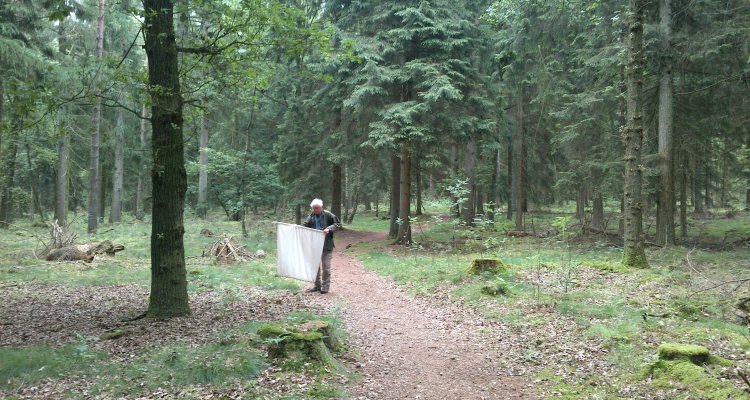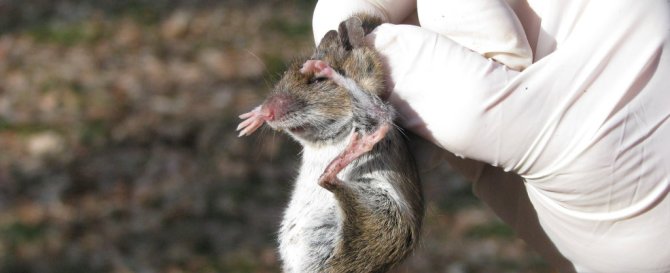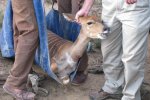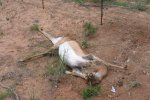
Project
Disease ecology
Traditionally, ecologists studied only “healthy animals and plants” while doctors and veterinarians studied the effects of microorganisms and pathogens on animals and people. However, with the emergence of the ‘One Health concept’ (www.onehealthinitiative.com) it becomes increasingly clear that these disciplinary boundaries are an impediment to improve the health of people, livestock and wildlife. Hence, ecologists can contribute to ‘One Health’.
The Resource Ecology Group has identified this as an important new development: we have been working hard on movement ecology, and in combination with our knowledge on the ecology and distribution of wild living herbivores and predators, we can make an important contribution to the understanding and control of diseases in which animal hosts and/or vectors are important. Moreover, infectious diseases play a primary role in ecological, social and evolutionary processes, but the drivers of such diseases are often still poorly understood. Our group is an important player in Disease Ecology and we will concentrate on zoonotic, vector-borne or livestock-wildlife related disease transfer, focussing on a distinctive group of vectors or carriers. The mission of our Disease Ecology Programme is: “To improve understanding of wild animals as vectors of (zoonotic) diseases through conducting state of the art animal ecology”. These studies are typically carried out in collaboration with molecular ecologists, veterinary experts, and epidemiologists. Besides initiating new research projects, we also teach courses in Disease Ecology at the highest possible academic level.

Our expertise is based on why and how animals are moving, which can have large consequences for disease transmission and dispersal. We concentrate on the issue of resource acquisition to explain movement and distribution of animals: what are the most optimal ways of animals moving through a multi-dimensional space, given a particular resource distribution (Hengeveld et al. 2009). So far, attention was paid to the optimal foraging strategy in a landscape that differs in density of resources. Our group added the effect of resource aggregation and resource quality on resource acquisition (Hengeveld et al. 2009; Huisman 2014). We then started looking at real animals (first with goats, De Knegt et al. 2007), and put radio-collars on some of the species under study: a large data set of movements of African elephant was thus collected and analysed (De Knegt et al. 2010, 2011). We also use camera-trapping and other techniques to quantify animal movements, densities and community compositions over different gradients of disturbance. We do this in the tropics as well as in temperate areas. Using these approaches, we now better understand how daily and seasonal movements of large herbivores are related to resources availability at different spatial scales, which are important to understand disease spread and difference in prevalence rates. Moreover, top-down forces, such as predation risk, but also the risk of infections by parasites and pathogens, co-determine the distribution of their hosts, and these interactions increase the complexity of host-pathogen interactions.
An important result of De Knegt’s work was that temperature plays a significant role not only in habitat selection but also in explaining movement patterns, and hence in determining animal distribution. This we investigated through the implantation of thermologgers in the abdominal cavity and thermometers on top of the head of eland antelopes, wildebeest and impala in two climatically contrasting areas, showing that temperature indeed plays a significant role in species’ distribution and habitat selection (PhD Shrestha).
New molecular tools enable us to take on the movements of wild geese as possible vectors of avian influenza: the results are clear and show that they can carry such a disease and that migrating wildfowl are important vectors that might be implicated in the spread of avian influenza (Si et al. 2009, 2010, 2013). Hence, changes in landscape configuration can modify migration routes, and thereby also change disease risk through changes in movement of infected birds (PhD Grishchenko, Xu, and Shenglai). Additional analyses show that geese wintering in the Netherlands pick up AI viruses on their wintering grounds and not before suggesting that arctic breeding species unlikely disperse Asian AI viruses from their Siberian breeding grounds to their European wintering areas (Kleijn et al. 2010, Shenglai et al. 2017). Genetic exchange of material can also be related to large probabilities of disease transmission. For instance, we analyse how corridors linking different habitat fragments influence genetic exchange (PhD de Jong), which could potentially also affect the spread of diseases through increased dispersal of their hosts. To better quantify the genetic landscape, we developed SNP-sets for the genetic typing of mallards from all over the northern hemisphere: they prove to be panmictic (Kraus et al 2012). For sampling, we developed the use of FTA-cards for the safe transportation of blood and faecal samples from all over the world (Kraus et al. 2010, 2011). For wild boar we have demonstrated recent genetic introgression from domestic pigs into wild boar populations with large implications for disease transmission (PhD Goedbloed). The movements of geese have taken us further, so that we now understand much better their migratory behaviour (Jonker et al 2010, 2011) through both modelling work (PhD Shenglai) and detailed genetic analyses. We have linked this to research on personalities of leading and following in geese (e.g., Kurvers et al. 2010, 2011).

We started research on Lyme’s disease and especially the ecology of ticks in relation to the occurrence of roe deer and mice. To understand mouse behaviour and movements better, we investigate the resource distribution of acorns and the effect of hoarding by mice (Suselbeek et al 2013). In a large field study, we studied and quantified the relationships between tick densities, Borrelia infection and host densities (Hofmeester et al 2016, 2017). Mice densities are key factors in these relationship, but also the presence of roe deer and other species increase the densities of ticks. An intriguing result is that predator species are able to reduce Borrelia infection prevalence through their negative effect on home ranges of mice (TED talk Hofmeester, Hofmeester et al 2017).
We also analysed interactions between host genetics, body condition and bovine tuberculosis (bTB) in African buffalo, showing that the genetic background played a critical role in disease transmission (Van Hooft et al. 2007, 2010). This work can have important implications for management of bTB at the human-livestock-wildlife interface. BTB was further studied in Ethiopia (Dejene et al 2016, 2017), showing that herd size and herd movements are key factors increasing bTB infection risk, but also that social factors, such as the exchange of cattle, are risk factors (Dejene et al 2017).
Understanding the factors driving parasite prevalence and the spread of infectious diseases is at the heart of disease ecology. The effects of habitat disturbance and land use changes on the prevalence of animal parasites, with associated risk of infectious disease transmission, are still poorly understood. By improving our understanding of the relations between anthropogenic and natural stress factors on health aspects of lemurs (parasites, microbiome, and MHC II) we increased our insight into disease prevalence in wild non-human primates (PhD de Winter). Land use changes also affect the mobility and distribution of hosts, such as shown by the effect of the decrease in wetlands in Southeast Asia (PhD Xu), and its consequences on the migrations strategy of migratory wildfowl and its potential to spread avian influenza (PhD Shenglai).
We also showed that disease competence is related to species traits, which has large consequences for the loss of species in disturbed systems (Huang et al 2015, 2016). These relationships are probably at the basis of the so-called dilution effect, the negative effect of species richness on disease prevalence. The dilution effect has recently attracted large attention, especially in relation to the world-wide increase in habitat fragmentation and decrease in species richness. This species richness – disease prevalence relationship was also detected in bTB outbreaks in cattle in Africa (Huang et al 2013, 2014). However, some hosts species are more important than others, and so-called identity effects (i.e. certain reservoir hosts that play a key role in increasing the prevalence of a disease) should not be ignored, such as the role of kudu in bTB transmission (Dejene et al 2017). Moreover, a larger similarity in taxonomic relatedness of the different species in an assemblage might contribute to a larger chance of disease outbreak (livestock diseases: PhD Wang; Avian Influenza: Huang et al, under review). We also studied how the community composition of vertebrates affect the parasite assemblage such as ticks and fleas, and ultimately agents of infectious diseases, including diseases that are harmful to people, such as the Rocky Mountain Spotted Fever caused by Rickettsia bacteria. We determined how host-specific parasites are to vertebrates, how host-specific disease agents are to their parasite hosts, and how suitable different vertebrates are as reservoirs for diseases (PhD Esser).
At present, we have initiated new research initiatives that focus on the ecology of diseases, the spread of diseases in relation to movement of hosts, and the underlying causal mechanisms that drive these movements and change disease prevalence.

